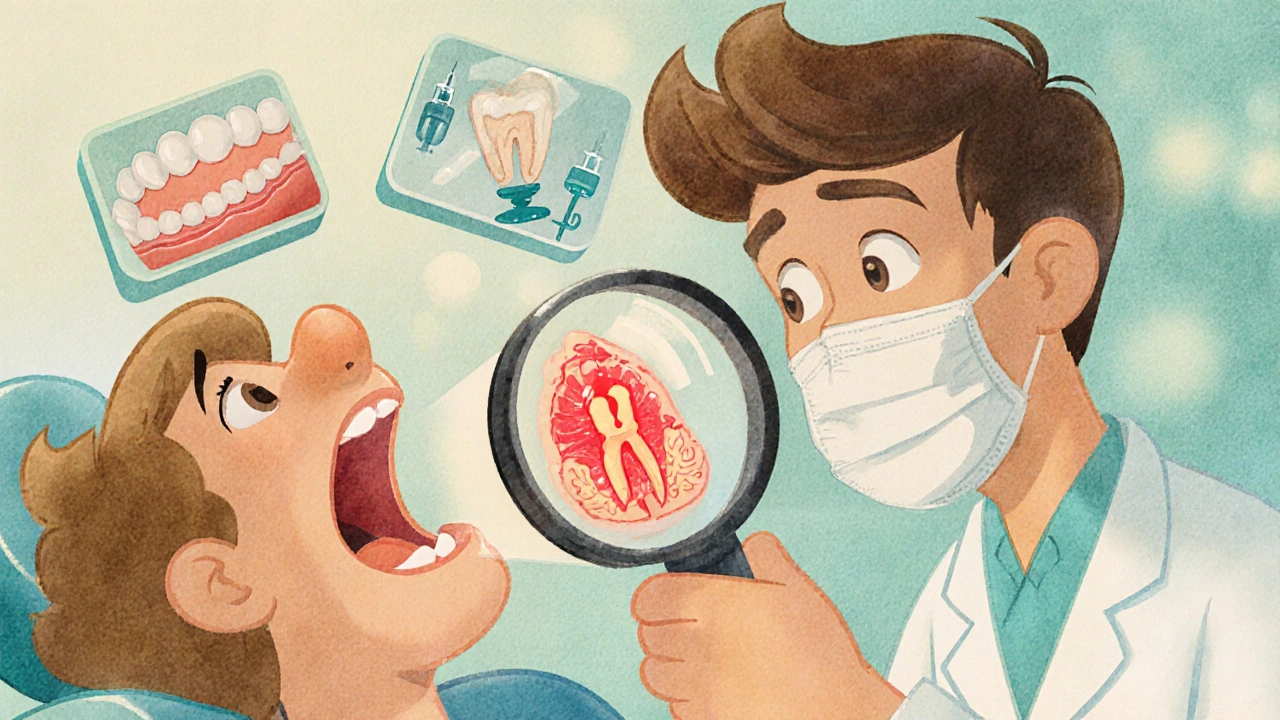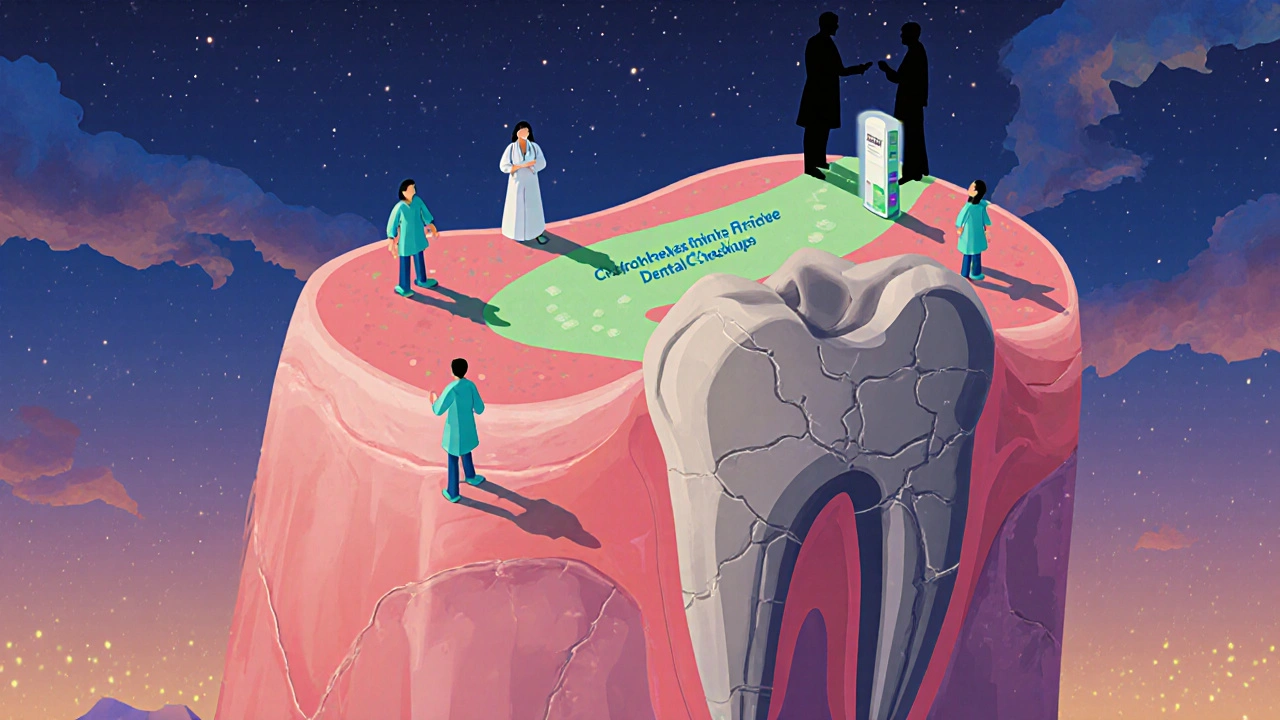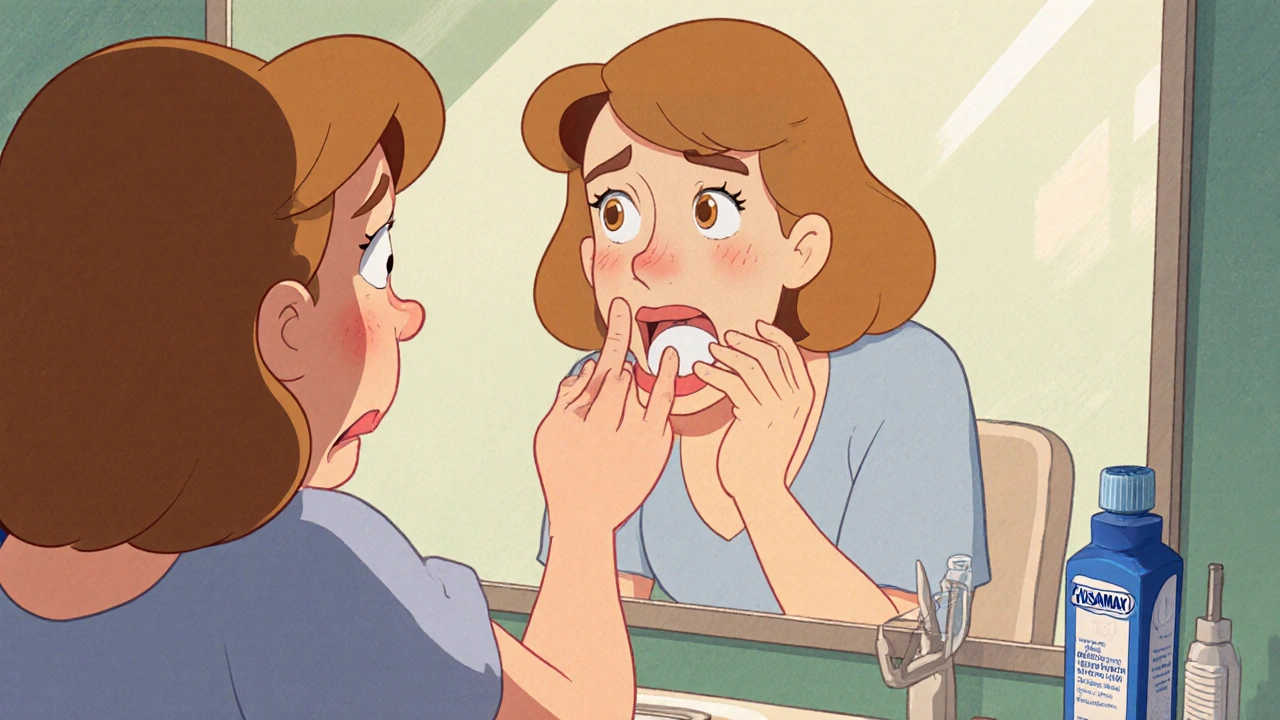Imagine going to the dentist for a simple tooth extraction, and weeks later, you can see bone sticking out of your gum. It doesn’t heal. It hurts. Your dentist says it’s an infection, but antibiotics don’t help. This isn’t a rare nightmare-it’s osteonecrosis of the jaw, and it’s happening to people taking common osteoporosis and cancer drugs. The good news? You can spot it early. The bad news? Most people don’t know what to look for until it’s too late.
What Exactly Is Osteonecrosis of the Jaw?
Osteonecrosis of the jaw, or ONJ, is when the bone in your jaw dies and becomes exposed. It doesn’t heal on its own. For at least eight weeks, you’ll see bare bone through open sores in your gums. This isn’t a cavity. It’s not a gum abscess. It’s bone tissue that’s lost its blood supply and can’t repair itself.
This condition is called medication-related osteonecrosis of the jaw (MRONJ) when it’s caused by drugs. The main culprits are bisphosphonates like alendronate (Fosamax), risedronate (Actonel), and zoledronic acid (Reclast). Denosumab (Prolia) and romosozumab are also linked. These drugs are lifesavers for people with osteoporosis or cancer that’s spread to the bone. But they work by shutting down bone turnover-slowing down the natural process where old bone breaks down and new bone grows. That’s great for stopping fractures. But when your jaw gets injured-even slightly-it can’t heal properly.
The risk is tiny for most people. If you’re taking oral bisphosphonates for osteoporosis, your chance of developing ONJ is between 0.001% and 0.01%. That’s about one in 10,000 to one in 100,000 people per year. But if you’re getting intravenous bisphosphonates for cancer, that risk jumps to 1% to 10%. That’s 100 to 1,000 times higher. And it’s not just about the drug-it’s about what happens after.
These Are the Real Warning Signs (Not Just Pain)
Many people think ONJ starts with pain. But pain isn’t always the first sign. In fact, some people have no pain at all in the early stages. Here’s what actually shows up:
- Exposed bone-This is the defining feature. You’ll see white, hard tissue sticking out of your gums after a tooth extraction, or even without any procedure.
- Poor healing after dental work-If your gums haven’t closed up four weeks after a tooth pull, that’s a red flag. About 76% of diagnosed cases started this way.
- Loose teeth-Not from gum disease. Teeth that suddenly feel wobbly for no clear reason, especially if you’ve been on these meds for over three years.
- Swelling or pus-Gums that are red, swollen, and oozing fluid. Often mistaken for a routine infection, but it won’t respond to antibiotics.
- Jaw numbness or heaviness-A feeling like your jaw is full of cement. This happens in 42% of cases and is often overlooked.
- Chronic bad taste or odor-Even after brushing, you can’t get rid of a metallic or rotten taste in your mouth.
One patient from Leeds, who took alendronate for five years, noticed a small white patch near her lower molar after a filling. Her dentist called it a minor irritation. Six months later, the bone was visible. She had to have part of her jaw removed.
What Triggers It? It’s Not Just Tooth Extractions
Most people assume ONJ only happens after major dental surgery. That’s not true. While tooth extraction is the most common trigger-3.2% of bisphosphonate users develop ONJ after one-it’s not the only way.
Even routine cleanings can cause tiny gum injuries that lead to ONJ in high-risk patients. Ill-fitting dentures rubbing against the gum line. A hard bite. A dental implant placed without proper screening. All of these can be enough to start the process.
The biggest risk factor isn’t the drug itself-it’s timing. If you start bisphosphonates or denosumab without a full dental checkup, you’re putting yourself at risk. Studies show that patients who had dental work done before starting treatment had a 92% lower chance of developing ONJ. That’s not a suggestion. That’s a medical protocol.
And it’s not just about the drug. People with diabetes, poor oral hygiene, or who smoke are at higher risk. The combination of medication and inflammation from gum disease creates a perfect storm.

Who’s at Risk? It’s Not Just Older Women
Most people think ONJ only affects elderly women with osteoporosis. That’s partly true. About 80% of cases are in women over 65 taking oral bisphosphonates. But the fastest-growing group is cancer patients-men and women-who get monthly IV infusions of zoledronic acid or denosumab to stop bone metastases.
One study from the University of Edinburgh found that after three years of continuous bisphosphonate use, the risk of ONJ jumps from 0.002% to 0.015%. After five years, it’s nearly 15 times higher. That’s why doctors now recommend a dental evaluation before starting treatment-and a follow-up every 12 to 24 months if you’re on long-term therapy.
And here’s something few know: ONJ can happen even if you’ve stopped the medication. The drugs stay in your bone for years. So if you took Fosamax five years ago and now need a tooth pulled, you’re still at risk.
What Should You Do If You’re on These Medications?
There’s no magic pill to prevent ONJ. But there are clear steps you can take:
- Get a full dental exam before starting-If you’re about to begin bisphosphonates or denosumab, schedule a complete checkup 4 to 6 weeks before your first dose. Any loose teeth, infected gums, or abscesses need to be treated before you start.
- Tell every dentist you see-Don’t assume they know. Say it clearly: “I’m taking [drug name] for [osteoporosis/cancer].” Write it on your medical card. Put it in your phone notes. This is critical.
- Avoid invasive procedures if possible-If you’re already on the medication, postpone extractions, implants, or bone surgery unless absolutely necessary. Fillings and cleanings are safe.
- Use chlorhexidine mouthwash-A 0.12% rinse, twice a day, reduces ONJ risk by 37% in high-risk patients. It’s available over the counter in the UK.
- Watch for early signs-If you’ve had dental work and your gums aren’t healing after two weeks, see a specialist. Don’t wait.
Patients who followed these steps had almost no ONJ cases. Those who didn’t? 65% said they were never warned about the risk before starting treatment.

What Happens If It’s Not Caught Early?
Early-stage ONJ (Stage 1) can often be managed with mouth rinses, antibiotics, and careful cleaning. But if it’s ignored, it can spread. Bone dies. Infections set in. The jaw can fracture. You might need surgery to remove part of your jaw. Some patients lose teeth, speech, or the ability to eat normally.
There’s promising new research. A 2023 study from UCSF found that teriparatide (Forteo), a bone-building drug, helped heal early ONJ in 78% of cases-compared to just 32% with standard care. But this isn’t widely available yet. Prevention is still your best defense.
Why So Many Cases Are Missed
Here’s the ugly truth: most dentists aren’t trained to recognize ONJ. In 2015, only 42% of U.S. dental schools taught it. By 2022, that jumped to 87%. But in private practices, especially outside big cities, awareness is still low.
Patients report being told they have “just an infection” for months. One Reddit user from Manchester waited nine months before a specialist finally diagnosed his ONJ. His dentist had prescribed antibiotics four times. He lost two teeth. He had surgery.
The problem isn’t malpractice. It’s lack of communication. Many doctors assume the dentist knows. Many dentists assume the doctor told the patient. No one says it out loud.
What’s Changing Now?
Things are getting better. In 2021, the FDA required all bisphosphonate and denosumab packaging to include clear dental warnings. In June 2023, the European Medicines Agency started requiring patient education materials with these drugs. The American Dental Association now recommends pre-treatment dental exams as standard care.
But the biggest change? The rise of interdisciplinary care. Hospitals and clinics are now linking oncology, rheumatology, and dental teams. Electronic records are sharing medication lists. Dentists are getting alerts when a patient starts a high-risk drug.
By 2028, experts predict a 40% drop in ONJ cases thanks to better coordination. But that won’t help you if you’re not informed now.
You don’t need to stop your medication. You don’t need to fear the dentist. You just need to be aware. If you’re on these drugs, your jaw is your frontline. Treat it like your heart or your lungs. Because when bone dies, it doesn’t come back.

Comments
Abhi Yadav
life is just a series of trade-offs bro 🤷♂️ you want to live longer? cool. but your jaw might turn into a fossil. nature don't care if you're 'informed'.
On November 19, 2025 AT 20:50
Julia Jakob
i got my teeth pulled last year after being on fosamax for 4 years. doc said 'it's fine' so i trusted him. now i got a ghost tooth hole that never closes. i dont even wanna look in the mirror anymore. 🤢
On November 19, 2025 AT 22:39
Robert Altmannshofer
this is one of those things that should be shouted from rooftops. if you're on these meds, your dentist needs to know like, yesterday. i'm a dental hygienist and i've seen people ignore this until they're in excruciating pain. don't be that person. talk to your care team. seriously. your jaw matters.
On November 21, 2025 AT 12:59
Kathleen Koopman
so if i’m on Prolia and need a filling… is that safe?? 😬 i’m so scared to go back to the dentist now…
On November 23, 2025 AT 00:30
Nancy M
In the United States, the medical-industrial complex often prioritizes pharmacological intervention over preventive dental care. This is not an isolated incident-it reflects a systemic failure in interdisciplinary communication. One must advocate relentlessly for oneself.
On November 24, 2025 AT 01:50
gladys morante
they told me it was 'just gum disease' for 8 months. then i saw the bone. white. like a little tombstone in my mouth. no one warned me. no one. not my oncologist, not my dentist. i feel like i was set up to fail.
On November 24, 2025 AT 03:04
Precious Angel
this is all part of the pharmaceutical conspiracy. they don't want you to know the truth-these drugs are designed to make you suffer slowly so you keep buying more meds. the bone doesn't heal because they don't want it to. they make billions off your pain. you think they care about your jaw? they care about your bank account.
On November 25, 2025 AT 10:43
Bethany Hosier
Dear Reader: It is imperative that you consult with your prescribing physician and your dental professional prior to initiating any bisphosphonate or denosumab regimen. Failure to do so may result in irreversible morbidity. Please ensure all documentation is properly filed.
On November 25, 2025 AT 18:57
Krys Freeman
why are we letting big pharma ruin our teeth? this is why america sucks. get off the meds. go natural. eat bone broth. stop being weak.
On November 26, 2025 AT 06:26
Shawna B
so just dont get teeth pulled if your on these drugs right?
On November 26, 2025 AT 19:54
Jerry Ray
i got mine after a cleaning. no extraction. just a little scrape. they said it was 'normal irritation'. three months later i had a hole in my jaw. now i'm on antibiotics every 2 weeks. this isn't rare. it's just ignored.
On November 27, 2025 AT 00:19
David Ross
I must emphasize, with the utmost seriousness, that the failure of healthcare providers to communicate the risks associated with bisphosphonate therapy constitutes a gross dereliction of duty. The absence of mandatory pre-treatment dental screening protocols is a national scandal. We must demand systemic reform.
On November 28, 2025 AT 08:18
Rachel Nimmons
they put me on Fosamax because I'm a woman over 65. now I can't eat an apple. I'm not a patient. I'm a lab rat. And they're watching. Always watching.
On November 29, 2025 AT 09:55